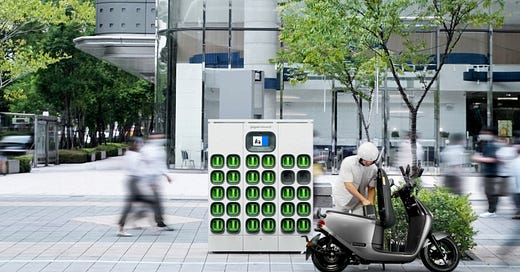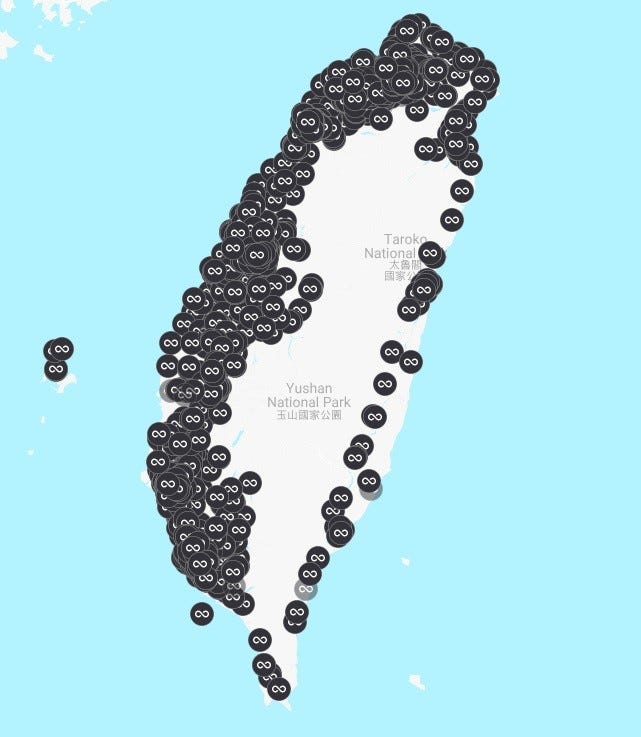🔋 Swap a battery, keep moving!
Innovations in electric vehicles charging might well impact how we move around cities in the near future. Miracle or mirage? Issue #20
Happy Wednesday everyone!
In today’s issue, we’ll dive into the promises that some charging technologies hold in regards to how we move around cities through electric vehicles (whether small or big).
The future of mobility is electric and with it new challenges arise. From micromobility devices, such as e-scooters or e-bicycles, to e-mopeds, e-motorcycles or electric cars, fast charging and increased range – the distance that a vehicle can run on a single battery charge – are among the biggest concerns gathering the attention lately.
How to ensure that micromobility and lightweight vehicles, relying on electricity, get smoothly charged in dense cities, without compromising on the user experience and the ability to serve as many people as possible?
Innovations in that space come straight from Asia, in the name of battery swapping stations.
Battery swapping involves switching dead batteries for ones that are fully charged, rather than the more common method of recharging exhausted batteries at a charging station. Battery swapping stations offer a quicker solution to address range anxiety, where each battery swap takes seconds and requires much smaller space to install compared to charging stations.
Taiwan-based battery-swapping leader Gogoro recently announced that there will soon be more battery swapping stations than petrol stations in Taiwan. As this technology expands to India, China and beyond, its impact will grow exponentially with every swap.
What does it mean for cities? Are swapping stations going to accelerate the electrification of mobility? How will these stations find their way in the dense urban fabric?
Accelerating the use of electric vehicles, big or small, is going to be an important part of any plans to stave off further climate change. That being said, the road to climate-friendly urban mobility is a long one and we should look carefully before leaping too quickly into solutions.
“Swap a battery, keep moving!” or the promises of electric vehicle charging innovations, that’s our topic for this week.
Last call for the Cities in Mind feedback survey! I have received great contributions and I’d love to get some more. Please take 5 mins to fill it and help me improve the newsletter and the podcast.
Don’t forget to subscribe to Cities in Mind, spread the newsletter around you or drop this issue into one of your company’s Slack channels !
⚡ Fixing range anxiety
Electric mobility is on the rise and with it come new challenges.
Among them, the lack of adequate charging facilities in cities is a major problem for electric two-wheeler and three-wheeler owners, but also for owners of lighter micromobility devices such as e-scooters and e-bikes.
The majority of the drivers of these vehicles need to charge their vehicles twice a day through a plug, since a single charge is sometimes not sufficient to run them throughout the day. Many riders suffer from what we call range anxiety, meaning the concern that the vehicle battery range might not be sufficient to reach their destination.
For those who rely on two-wheeler, three-wheeler or micromobility e-devices for their daily business (for example, food delivery), charging these vehicles in the daytime, for two to three hours during peak business hours, results in a loss of income.
Starting around 2007, some companies in China, the United States, and Israel (such as Better Place) started to explore this issue and design solutions to ease charging access for electric vehicles. The idea of swappable batteries was first introduced for electric cars but it was quickly judged too complicated, in part because of the high cost of building charging facilities and the time needed to charge much larger cells.
For lighter-weight vehicles, the tech seems to work better.
Gogoro, a Taiwanese startup, introduced around 2015 a battery-swapping platform for urban electric two-wheel scooters, mopeds and motorcycles, leading to the installation of more than 2,300 “GoStations” outside convenience shops or in car parks across Taiwan. Those stations operate 24/7.
Why is Taiwan so advanced? Taiwan has actually the world’s highest density of motorcycles and is also one of the world’s major manufacturers of motorbikes, with an annual production of 943,303 units in 2020. Committed to curb pollution, Taiwan’s government pushed for the adoption of e-motorcycles, which in turn paved the way for the development of an energy-management infrastructure composed of swappable batteries and charging stations.
"Instead of the four-wheeler infrastructure that needs to be built, our system is really like a vending machine that goes into different locations based on where the consumer goes and where the consumer needs energy" said Gogoro Founder and Chief Executive Horace Luke
With more than 240 million battery swaps since 2015, Gogoro says it has kept about 360,000 tonnes of carbon dioxide out of the atmosphere. The facilities already outnumber petrol stations in four major Taiwanese cities and the firm's goal for 2022 is to "surpass the number of petrol stations island-wide".

The successful adoption of the battery swapping concept in Taiwan has given a boost to the market in the region. Becoming the de facto standard for powering electric two-wheelers in Taiwan, Gogoro has paved the way forward for smart battery swapping in cities in the region and beyond. China and India are the two biggest markets for electric two and three-wheelers in the world and also benefit from a high population density in major cities, which makes this kind of infrastructure conducive.
In Indonesia, ride-hailing giant and super-app Gojek has announced a strategic partnership with Gogoro to electrify two-wheel transportation in the country.
Growing two-wheeler sharing in Europe will also provide new opportunities to battery swapping players. Africa is also a potential huge market for such solutions, given the high base of two and three-wheelers in large cities.
⛽ A new city infrastructure
Will battery swapping stations soon invade our sidewalks ? What’s pretty clear right now is that electric lightweight vehicles and micromobility devices are coming and there aren’t many places to charge them in cities, where space is, by essence, limited.
As the battery swapping model expands and matures, its insertion within the urban fabric might take different forms, all the way from Gogoro’s compact kiosk-like GoStations to charging pods directly located inside local businesses or on under-utilised parking spots.
Tier, one of Europe's leading shared micromobility provider, has developed a model Four e-scooter which is powered by a battery that riders can unplug and exchange for a freshly-charged up unit.
The batteries are slotted into a “powerbox”, which is essentially a big charger capable of swallowing four batteries at a time. For every battery that a rider swaps, they earn a free ride unlock and 15 free minutes of scooting. The batteries weigh 6kg each; while not featherweight, that’s still manageable for many users.
Tier is installing charging pods directly in local businesses, such as shops, cafés and coffee houses, providing them free of charge and covering the electricity bills.
The company believes this could be a win-win deal. On one hand, Tier transfers the operation of swapping batteries to users and incentives them with free riding minutes. This reduces logistical complexity, improves up-time of scooters, and cuts carbon associated with travelling around to swap out batteries. On the other hand, local businesses benefit from the visit of battery swappers who will likely spend some spare cash on a coffee before zipping away.
Tier has conducted a six-week trial at a shop in Finland, where an average of 16 riders a day popped into to swap batteries, spending an average of €3.41 in store at the same time. The local price for a coffee.
Tier is essentially giving little shops the earning power of motorway service stations, without the middle-of-nowhere locations.
We could easily imagine how this kind of solutions could be developed at scale. While the benefits for local businesses, hosting battery swapping pods, might not be enormous, there are still interesting synergies which will ultimately lead to more people adopting e-scooters, e-bikes and other electricity-powered micromobility devices.
🤷 Miracle or Mirage?
A recent study conducted in Portugal suggested that battery-swapping technology might be the best solution for electric transport (including for electric cars), providing many advantages, especially in turning all transport energy needs into a flexible demand, without the need for fast charging.
The researchers also highlighted that battery swapping, which involves many different stakeholders, would need policy stimulus, significant investment, and industry participation. There is a need for universal standards for battery shape, insertion and electrical connection.
Is it too good to be true? In order to fully appreciate the environmental benefits of battery swapping, we need to step back a little and revisit the promises of electric mobility at large.
As many researchers have argued, the eventual environmental lifetime greenhouse gas emission reductions of electric vehicles and lightweight electric vehicles depend on multiple variables, including the driving range of the battery, the share of renewables in the electricity mix used in charging, the driving pattern, and the climatic conditions. Let’s dig into some of these variables.
First, as with all things electric, the power you fuel in the machine is as clean as the source of the power itself. If your electricity mostly comes from coal or gas, there’s nothing to brag about. The best swapping stations won’t hide the fact that your energy comes from dirty sources. If the share of renewables in your energy mix is high, the situation is different.
Let’s take the example of Taiwan, the most advanced place regarding battery swapping. In 2020, 45% of Taiwan's electricity generation came from coal, 35.7% from natural gas, 11.2% from nuclear, and 5.4% from renewables. Not so exemplary (but, who can claim to be?)
Then, there’s the problem of batteries themselves. Battery production is one of the most carbon-intensive parts of e-scooter manufacturing, which in turn contributes the most carbon to a scooter’s overall lifetime emissions. There is also growing concern about the increased demand for commodities and rare metals used in electric vehicle batteries. Five battery minerals are considered critical for Li-ion batteries, which are key for most electric mobility vehicles: cobalt, graphite, lithium, manganese and nickel. As you’ll see in the map below, some countries are more crucial than others to the battery metal supply chain, with China topping the list.
Battery recycling is gaining speed in Europe but is still far behind what needs to be achieved in order to reach real sustainability.

There are also risks of theft or damage, as the swapping operation is left to the users themselves. It’s a basic rule of engineering that the fewer moving parts there are, the fewer opportunities there are for friction, damage and risk. This problem is not limited to battery swapping but let’s say this kind of operation increases the risks of damages or minor accidents (Gogoro’s battery weighs 9kg).
Finally, the charging dilemma goes beyond the swapping stations. We have to also consider the power grid. Utilities maintain a balance of supply and demand by generating about as much electricity as is being used. What happens if there’s a surging need for juice all over the city, because it’s winter time, it’s cold outside and people work from home and want to heat their houses? What might be best for grids is actually less demand for electricity altogether.
As battery swapping technique matures, it might also expand to electric cars, again. As we’ve seen at the beginning, electric cars were the first targets for battery swapping but it did not work out. The challenges behind swapping batteries in cars are different than for two-wheelers or e-scooters but battery swapping could make electric cars easier to charge in cities and denser environments.
For the best and for the worst.. Electric cars might be better for the environment but they also make us think that it’s ok to continue driving individual automobiles, as long as it’s green. Having every city resident in their own electric car is not exactly what we wish for cities.
To conclude, battery swapping stations are not a catch-all solution but they are likely to leave their mark on cities across Asia Pacific, then Europe and maybe Africa. Mirage or miracle? Time will tell us.
🧐 Some resources around this topic
Wait, So Where Will Urbanites Charge Their EVs? Homeowners with garages can easily charge their electric cars, but not apartment dwellers. Here's what it'll take to get plugs everywhere in cities.
Understanding the risk of swappable e-scooter batteries These three critical tests will need to be passed to determine if swappable e-scooter batteries can overcome their safety and sustainability risks.
Why swappable batteries are the way to go by one of Europe’s leading micromobility startups, Dott. To swap or not to swap? This has been a fundamental question in micromobility circles: how to charge e-scooter batteries in the most efficient, safe, and sustainable way.
China’s Rare Earths ‘Slump’ A Sign Of Domestic ‘Hoarding’ For EV Batteries, And More An interesting article about the battle behind rare earth metals which power batteries and the global energy transition.
How Is This A Good Idea? Swap this technological dead-end out for better batteries, improved superchargers and more universal EV charging standards A different view on battery swapping, as the title suggests..
Experts warn that time is already running short to accelerate the transition to electric transportation, if climate change is to be stopped in its tracks. Fast-tracking a reliable charging infrastructure has become the consensus solution. Even that will require a Marshall Plan-level of political will, private investment and government support. In the face of this dire situation, battery swapping is a distraction and dead-end that the planet can’t afford.
That’s it for today. I hope you’ve enjoyed this contribution. As usual, a small 💚 at the bottom of this page goes a long way.
Thanks for your support and see you next week for a new issue.
Before leaving, don’t forget to fill the survey (last chance!) and share your views about the newsletter and the podcast!







Excellent, as always